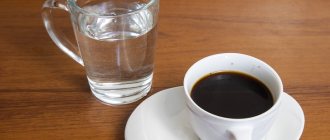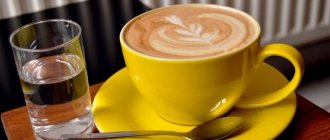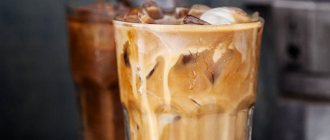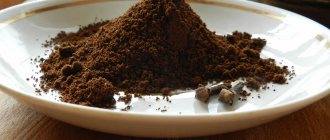Properly selected water is considered one of the conditions for deliciously brewed coffee. This is especially true for drinks prepared in coffee machines. After all, the quality of the liquid poured affects not only the taste characteristics of the finished product, but also the durability of the device itself. In order for your favorite espresso or Americano to reveal all the notes of the blend, acquire a dense body and rich aroma, the coffee powder must “give up” at least 18% of its mass to water. This is only possible with a moderate concentration of minerals in the liquid. They enhance the release of coffee oils, promote their complete dissolution, and make the extraction process balanced. Accordingly, they provide a smooth texture and optimal taste characteristics to the finished drink. We have prepared a TOP 5 rating of the best water for a coffee machine in 2022 .
Study! POLL: What kind of water do you drink?
Good bottled water for coffee machine
BonAqua "BonAqua" (Russia, Moscow region)
Supplied in plastic bottles with a capacity of 0.5/1.0/2.0/5.0 l. The label indicates total mineralization in the range of 50-500 mg/l, but in fact in 2-liter bottles there is about 156 mg/l, and in 5-liter bottles – 168 mg/l. The amount of calcium is 80 mg/l for any product, magnesium is within 50 mg/l. There is no foreign smell, taste or color.
| Package | plastic bottle |
| Mineral composition | magnesium - 5-40 mg/l, calcium - 15-45 mg/l, sodium 1-15 mg/l, potassium <5 mg/l, chlorides - 30-140 mg/l, bicarbonates <100 mg/l, sulfates < 20 mg/l |
| Additional Information | mineralization 0.1 - 0.35 g/l; shelf life 9 months; store at temperatures between 0°C and 35°C; keep away from direct sunlight; After opening, it is recommended to store the bottle with the lid closed at a temperature of 0°C to 10°C, consume the water within 24 hours |
Advantages and disadvantages
- optimal amount of minerals in 2-liter bottles;
- no chemical additives;
- no aftertaste;
- thanks to a sufficient amount of Mg, it reveals the taste of brewed coffee well;
- complies with SCA standard.
- 5-liter bottles may contain a higher concentration of minerals, which does not allow the desired density and texture of the drink to be achieved.
AquaMinerale "AquaMinerale" (Russia, Moscow region)
Colorless, odorless, with natural taste. Extracted from a natural source, contains the optimal amount of Mg (up to 20 mg/l) and Ca (up to 30 mg/l) cations. The label indicates a standard salinity range of 50-500 mg/l, but in reality the figure does not exceed 177, as recommended by the SCA association.
| Package | plastic bottle |
Advantages and disadvantages
- does not contain chlorine, foreign impurities, odor;
- extracted from a natural source, and not by artificial mineralization;
- has an optimal acid-base composition;
- Well reveals the taste of delicate latte and rich espresso;
- complies with SCA standard.
- There may be a low magnesium content, which deprives the drink of a pleasant sourness and expressive taste.
"Elbrus" (Russia)
It is extracted from mountain springs and has a natural composition. All components are optimally balanced, which is very important for brewing delicious coffee and safe operation of the device itself. Has no color, metallic taste, or foreign odor. Contains no more than 10 mg sodium and about 25 mg Mg per liter of liquid. Mineralization is optimal, although the label indicates a limit of 150-800 mg/l. In fact, it turns out about 127 mg of dissolved salts per liter of Elbrus (simply ideal!).
| Package | plastic bottle |
| Mineral composition | mg/l: hydrocarbonates 70-400; sulfates<50; chlorides<1000; calcium<100; magnesium<25; sodium+potassium<100 |
| Additional Information | mineralization 0.15-0.8 g/l |
Advantages and disadvantages
- soft taste;
- absolute transparency;
- no odors;
- ideal balance of minerals, acidity, alkalinity;
- contains a sufficient amount of magnesium, which has a positive effect on the development of flavor notes;
- complies with SCA standard.
- the cost may be slightly higher than previous brands.
SPA Reine
It is extracted from a natural source - the Source de la Reine spring, into which rainwater and streams flow after the snow melts. Therefore, it has a low level of mineralization (33 mg/l) and a very mild taste. Contains a small amount of calcium cations (about 45) and an optimal concentration of magnesium (17 mg/l).
But even with low TDS, it allows you to brew aromatic espresso with a dense body, smooth texture, and expressive (but pleasant!) acidity. Even a delicate latte prepared on this basis does not lose its taste and aroma characteristics.
| Package | plastic bottle |
| Mineral composition | calcium (Ca): 4.5 mg/l, magnesium (Mg): 1.3 mg/l, sodium (Na): 3 mg/l, potassium (K): 0.5 mg/l, hydrogen carbonate (HCO3) : 15 mg/l, chlorine (CI): 5 mg/l, sulfate (SO4): 4 mg/l, silicon (SiO2): 7 mg/l, nitrates (NO3): 1.9 mg/l |
| Additional Information | Storage conditions: at temperatures between 5°C and 25°C, store away from direct sunlight. |
Advantages and disadvantages
- very mild taste, no smell or color;
- low mineralization, which is good for coffee;
- natural filtration;
- rejuvenating effect on the body;
- Absolutely environmentally friendly.
- the mineral composition does not meet SCA standards, but allows you to brew delicious coffee;
- has low acidity, which is not always good for the body when drinking such water in its pure form every day.
Nestlé PureLife
It is extracted from an artesian well. It has an optimal total hardness of 3 mEq/L, but is oversaturated with sodium (almost 50 mg/L). At the same time, a magnesium concentration of 15 mg/l smoothes out this salt imbalance and allows you to achieve the desired taste from brewed coffee.
| Package | plastic bottle |
| Mineral composition | mg/l: HCO3 150, NA 50, CA 40, K 20, Mg 15 |
Advantages and disadvantages
- no iron taste;
- no smell or color;
- optimal rigidity;
- almost perfect overall mineralization.
- the sodium content is exceeded, which can make the drink taste “flat”;
- high price.
Experiment: TDS and taste
We tested several brands of water to confirm the theory that lower TDS benefits coffee. To do this, we checked the actual mineralization of all samples and organoleptically assessed the coffee they produced.
All samples were brewed in V60 according to the same recipe:
- 15 g coffee / medium grind
- 270 g water / 93°C
- Pour 50 ml of water in a circular motion from the center to the edge of the filter
- Stir the coffee with a spoon
- Pour in the remaining 220 ml of water in a circular motion.
- Easily swing the funnel with your hands, thereby removing coffee from the walls of the filter
- Total cooking time: 2.15 – 2.45 seconds
| № | Brand of water | Actual mineralization, mg/l | Total mineralization on the label, mg/l | Mg cations | Ca cations |
| 1 | Kalinov spring | 292 | <700 | 15 | 40 |
| 2 | Shishkin forest | 340 | <700 | 5 | 20 |
| 3 | Senezhskaya | 220 | 300-700 | 150 | 150 |
| 4 | Every day | 157 | <700 | 50 | 90 |
| 5 | Bon Aqua 2l | 156 | 50-500 | <50 | 80 |
| 6 | Bon Aqua 5l | 168 | 50-500 | <50 | 80 |
| 7 | VkusVill | 179 | 200-400 | 10-40 | 40-70 |
| 8 | Kozelskaya | 81 | <1000 | 65 | 130 |
| 9 | SPA Reine | 26 | 33 | 17 | 45 |
| 10 | Noringa* | 126 | 100-200 | 5-15 | 23-40 |
| 11 | Elbrus | 127 | 150-800 | <25 | <100 |
| 12 | Aqua Minerale | 177 | 50-500 | <20 | <30 |
* Since the experiment, Noringa has already been removed from sale.
General water quality standards for coffee machines
At the global level, general standards have been defined by which the quality of water for brewing coffee is assessed. The indicators are approved by the SCA (Specialty Coffee Association) and include the following values.
- The degree of total mineralization TDS is recommended within the range of 75-250 mg/l. Many baristas and coffee lovers believe that 120-150 mg/l is enough to make the drink dense, with the necessary sourness and developed flavor notes.
- Hardness is determined by the content of calcium salts and is considered normal at 4.5-5 mEq/l. In practice, it is recommended to use softer water 2-3.5 mEq/L. On labels, “calcium hardness” can be indicated in mg/l and range from 17 to 85. The optimal concentration is 68 mg/l.
- In addition to calcium salts, magnesium and sodium salts affect hardness. The last mineral (sodium salt) should be in a volume of up to 30 mg/l, or better yet, up to 10 mg/l. Otherwise, the taste of the drink will be weakly expressed and the aroma will not be fully revealed.
- Acidity is recommended in the range of 6.5-7.5 pH. It represents the balance of the acidic and alkaline composition of water. With an optimal pH value of 7, it provides the necessary depth of taste for Americano, latte, and macchiato.
Additionally, indicators such as smell, color, and amount of chlorine are taken into account. For high-quality water, the values of the listed parameters should not exceed zero.
Methods for self-softening water
Before softening liquid for coffee machines, it is necessary to properly filter it, reducing the concentration of bacteria, chlorine and heavy metal impurities. If you use bottled water, there will be no difficulties in preparing it, since in stores you can find products with the appropriate composition and taste properties.
If you want to connect the coffee machine to the water supply, it is important to carefully evaluate the quality of the water. Often it contains an excessive amount of hardness salts, iron and chlorine. Moreover, the composition often changes depending on the time of year.
Classic water softener
To soften water, any tank filled ⅔ with ion exchange resin is suitable. The device is used to soften liquids by replacing magnesium and calcium ions with sodium ions. However, the device is not capable of retaining all kinds of contaminants from the pipeline.
Not only sodium is suitable for softening water, but also other chemical elements that do not form scale. The key requirement for this treatment method is to maintain the pH of the water at least 7.
The advantages of classic water softeners include:
- Low cost.
- Life time.
- Efficiency of the initial cleaning cycle.
However, the device is not able to filter contaminants and requires frequent maintenance.
Modular filters with replaceable cartridges
They are a popular invention for water treatment. Existing types of filters are suitable for different purposes:
- Softening.
- Removing odors.
- Iron removal.
Cartridges are used as filtering surfaces.
Using a modular filter, you can purify water without the use of additional installations. But it is necessary to prepare a cartridge with filtration from 0.5 microns, otherwise small particles of dirt will end up in the boiler.
A modular filter is inexpensive and does a good job of softening water. However, when using it, it is important to regularly update the cartridges, which is accompanied by additional costs. This cleaning method is suitable for small coffee shops.
Reverse osmosis filtration system
The technology involves preliminary purification of water from rust, sand and organic inclusions. After this, filtration is performed at the molecular level using a membrane with pores of 0.0001 microns. Then the water is sent to a special tank, and foreign impurities are discharged into the sewer.
The device allows you to bring water to distilled quality with subsequent mineralization. For espresso coffee machines, it is better not to choose completely purified water, as it can cause the automatic liquid level in the boilers to fail due to the lack of conductive properties. In addition, such water causes damage to individual parts of the coffee machine.
The advantage of a reverse osmosis system is its high cleaning efficiency. However, the filter consumes a lot of water and is large in size.
Combination filter
The housing contains several devices for water treatment. They are used to remove iron and salts. The device contains several resins for the ion exchange procedure, which are mixed with granulometric material. This increases the efficiency of water softening several times.
Some filter models have an electronic meter to determine the level of liquid consumption.
The system is compact, and the process of replacing cartridges is simplified. However, such a filter costs from 15,000 to 100,000 rubles. depending on technical characteristics and cleaning features.
The degree of water hardness for a coffee machine: what determines it, how to choose
The taste of aromatic espresso, cappuccino with high foam, delicate latte depends on many indicators: the quality of the grain, its proper roasting, grinding, proportions of ingredients. Another important condition is the choice of good water for the coffee machine.
The liquid poured into the device must not only be free of large contaminants, foreign odors, and chlorine, but also contain the optimal amount of minerals. The latter affect the efficiency of dissolution of coffee particles and the richness of the finished drink. The concentration of salts of alkaline earth metals Mg and Ca is used to determine the “hardness” of water:
| Water hardness level | Value (in mEq/L) |
| Soft | up to 4 |
| Average | 4-8 |
| Tough | 8-10 |
| Very tough | over 10 |
In everyday life, we use water with a hardness level of 3.5-10 mEq/l. For drinking, soft water of 1.5-2.0 mEq/l is considered optimal. It is also suitable for brewing coffee, which fully reveals the flavor and aroma characteristics specified by the manufacturer.
In too hard water (with a high percentage of Ca and Mg salts), coffee particles dissolve poorly, so the drink turns out tasteless, “flat”. Especially if it is brewed from lightly roasted beans. When boiling, mineral impurities crystallize and settle in the form of “flakes” on the internal surfaces of the brewing unit of the coffee machine. Over time, a sediment forms, which not only negatively affects the taste characteristics of the coffee, but also “corrodes” metal parts, sealing gaskets, and accelerates the wear of the device.
If it is too soft (when calcium and magnesium salts tend to “0”), the extraction process is unstable, which often makes the taste characteristics of espresso, Americano, and ristretto too “bright.” You can feel this when brewing ground beans of medium and strong roast, which give the finished drink a sufficiently bitter taste. In this case, the density of the body also “suffers”; sometimes there is not enough sourness, because the low concentration of Mg salts does not allow “pulling” a sufficient amount of acid from the coffee grind.
Interesting! Since 2014, a new interstate standard has been used, according to which water hardness is expressed not in mg-eq/l, but in degrees °W. It is generally accepted that 1°F = 1 mEq/L.
How to choose?
According to the composition on the label. It is not necessary to check all the parameters with the table from the previous paragraph, but pay attention to the overall mineralization. Manufacturers usually indicate a range of TDS values. At home, the actual TDS can be measured with the simplest pocket TDS meter (salinity meter, conductivity meter).
Why is water from a source or well not suitable? Due to increased rigidity. Groundwater dissolves rocks containing calcium and magnesium (limestones and dolomites), so they are harder than surface water. At the same time, the hardness of surface waters is subject to seasonal fluctuations: the minimum hardness occurs in the spring, when the sources are replenished by melting snow and rain, and the maximum in the winter.
What about tap water? It is different in different regions, so I cannot draw general conclusions here: you need to experiment. I will only say that tap water is also subject to seasonal fluctuations in hardness. At my house, coffee made with Aquaphor-filtered tap water turns out less tasty than bottled water.
What is total mineralization
Alkaline earth metal salts are present in drinking water:
- calcium – in the greatest quantity 193 mg/l;
- magnesium – about 58 mg/l;
- sodium – up to 10-30%;
- zinc – up to 5%;
- potassium – within 4-5%;
- phosphorus – 4%.
Their dissolved mixture is called total mineralization. The level of water hardness depends on the concentration of all minerals and salts, and the taste of the prepared coffee depends on the optimal balance.
It was mentioned above that the recommended indicator of total mineralization is 150 mg/l of liquid. If this figure is higher (for example, 200 mg/l), then the brewed drink from heavily roasted beans will taste bitter, and the subtle notes of aroma will remain undisclosed. When brewing lightly roasted coffee with such water, you risk not feeling its taste at all.
Professional water treatment systems
Many coffee shops, where they are attentive to the quality of water and the taste of their products, use professional cleaning systems. The system purifies water, making it practically distilled. Next, mineralized water is added. This technique allows you to adjust the mineralization rate and achieve a suitable ratio.
The only problem with purification systems is the cost. The unit is suitable for mass use, for example, for a coffee shop where more than 120 cups are made per day. For home use, cleaning systems will be too expensive.
Alkalinity
Another criterion for choosing good water for a coffee machine. The fact is that a liquid with a high alkalinity actively absorbs (neutralizes) all types of acids contained in Arabica and Robusta. As a result, the drink lacks taste in the literal sense of the word. It turns out “flat” and loses its flavor. Low alkalinity, on the contrary, makes espresso more “bright” and emphasizes its taste characteristics.
A separate story with distilled water, which until it comes into contact with oxygen has a perfectly balanced acid-base balance. But when you open such a bottle, the liquid begins to actively become saturated with carbon dioxide and acquires a noticeable sour taste. Accordingly, when brewed in Americano, ristretto turns out to be sour, which can be noticed even by those who are not fond of coffee.
Advice! Regular soda will help balance the acid that distilled water has “acquired” in an open bottle. It is dissolved at a rate of approximately 100 mg per liter. In fact, a total TDS mineralization indicator of about 50 mg/l is obtained, which is slightly below the recommended minimum. Total alkalinity will be up to 40 mg/l (within normal limits).
Filtered
What about water treated in a coffee machine filter? For the coffee machine to work smoothly, the water must be soft, free from impurities and have a pleasant taste.
As is clear, the water filter must be selected for a specific brand of coffee machine. And because most of the manufacturers are Europeans, their filters are designed for water with Euro properties, which are higher than Russian ones. This affects the service life of the filter, but within 1.5 - 2 months the water will be clear. If you continue to use a dirty filter, the water will not be purified as it should, scale will appear in the machine and the load on the pump will increase.
So what is the benefit of using a filter? Take a closer look at the cleaning process.
- 1st step: Filtration through a narrow mesh. This is mechanical cleaning of sand and other small particles.
- 2nd step: Ion exchange. At this step, the water is purified from heavy metals and softened.
- 3rd step: Activated carbon. The liquid passed through a layer of activated carbon acquires a more pleasant taste and smell, and is cleared of chlorine and pesticides.
- 4th step: Saturation filtering. Another layer of small mesh prevents small particles from remaining in the water.
Some people prefer to use bottled water to make coffee. This option will free you from worrying about the operation of the machine. But you should take only clean filtered water, without adding minerals and other substances necessary for human health.
Tip 1: How to make delicious coffee in an ordinary drip coffee maker.
How to choose water for a coffee machine on a supermarket shelf
We focus on the label - it should indicate the SCA parameters (odor, color, chlorine, total mineralization TDS, calcium hardness, total alkalinity, amount of Na, pH level). Sometimes manufacturers neglect certain data other than the TDS range.
Of course, by general mineralization you will not determine the specific composition of dissolved salts, but you can focus on the degree of hardness:
- with high TDS, the water will be hard and will not reveal the flavor and aroma characteristics of the brewed coffee;
- at a low level, the finished drink will be frankly sour, with distorted notes of taste and aroma.
How to change the composition of coffee water
There are several ways to achieve ideal water parameters. The most budget-friendly option is to use a household filter for cleaning
.
With its help you will remove chlorine, heavy impurities and add minerals. But the composition of water varies even within the same city, and standard filters are sold. Therefore, sometimes these measures may not be enough. Many coffee lovers buy bottled water
.
Its characteristics are indicated on the packaging, so all that remains is to compare our table with the manufacturer’s information and select the one you need. Just be careful with water from wells: the composition on the label is often suitable, but in reality it turns out to be oversaturated with minerals and is not suitable for coffee. In our experience, a delicious drink is obtained with Aqua Minerale and Bon Aqua water. But you can trust your feelings, experiment with different brands and choose the one you like best. For mass preparation of coffee, we recommend installing professional filters
, especially those designed for catering and office premises, for example, Everpure. The equipment can withstand heavy loads and protects equipment well from scale. If you're planning to open a coffee shop and want customers to come back again and again, don't skimp on cleaning systems.
A few more words about water for coffee
We chose water with the ideal composition and were almost at the finish line. All that remains is to decide on its quantity and temperature. There are much fewer numbers here and everything is simple:
- 1 unit of coffee requires 17 units of water;
- The optimal temperature is 90-96°C.
The correct ratio of grinding and water at the right temperature will allow you to make delicious coffee even for a beginner. Try it and see for yourself.
Is it worth buying water from a well?
Here you can say both “yes” and “no” - it all depends on the season. If water is taken in winter, too many salts and rock minerals get into it and dissolve. This condition significantly increases the calcium hardness indicator, which negatively affects the taste of brewed coffee and the safety of operation of the device (scale actively deposits on the internal surfaces of the brewing unit). In spring, on the contrary, the concentration of minerals is reduced to a minimum, since freshwater streams formed by melted snow and frequent rains flow into underground springs.
A separate issue is water from local water supplies. It is supplied from different reservoirs, initially differs in mineral composition, and must undergo standard purification before serving to the consumer. As a rule, many houses and apartments additionally have reverse osmosis systems installed, which also affect the final quality of the natural resource. Therefore, if you decide to save money by not buying specially prepared water for a coffee machine, but using home filtered water, experiment. But the taste of the prepared drink will then be in question.
POLL: What kind of water do you drink?
Rigidity
Salts dissolved in water are characterized by hardness. This parameter depends on the area where the water is extracted. Many people observed the consequences of hardness in kettles and washing machines in the form of a white precipitate.
Firstly, high hardness affects the brewing of coffee itself, extraction is much worse and the coffee loses some of its taste.
Secondly, hard water leads to breakdowns of the coffee machine due to limescale.
Brief summary
If the total mineralization of water for a coffee machine exceeds 200 ml/g, then the “zest” that you expected from the type of beans, grinding, and roasting will disappear in the finished drink. Some of the taste characteristics will disappear, some aromatic notes simply will not be revealed. But you will definitely feel the obvious bitterness and unpleasant aftertaste.
If the TDS value on the label is in the range of 80-120 mg/l (in some cases even 180 mg/l), then you can expect a full disclosure of flavor and aromatic characteristics from your favorite drink. All notes of aroma, taste and aftertaste declared by the manufacturer must clearly manifest themselves. Of course, provided that the coffee is brewed correctly.
Some baristas advise preparing espresso with very soft water with a total mineralization no higher than 50 mg/l, a sufficient amount of magnesium salts and a neutral pH value (pH 7). It is recommended to avoid the presence of sodium (10 mg/l is sufficient), since it distorts the inherent sweetness and sourness of coffee beans.
Is filtered water okay?
Unfortunately, the water filters installed in coffee machines do not handle very “hard” water. Over time, the salts and minerals of “hard” water still form sediment, which reduces the water pressure when making coffee and causes noise when the machine operates.
Household filter jugs work to remove odors and tastes from tap water, but do not adequately soften the water. They also do not provide rational characteristics of water mineralization.
That is why in elite coffee shops, in addition to installing a filter in the water hopper, they also connect a reverse osmosis filter to the coffee machine. But they are not cheap, so not everyone can afford to connect a filter system with reverse osmosis to their coffee machine at home.











